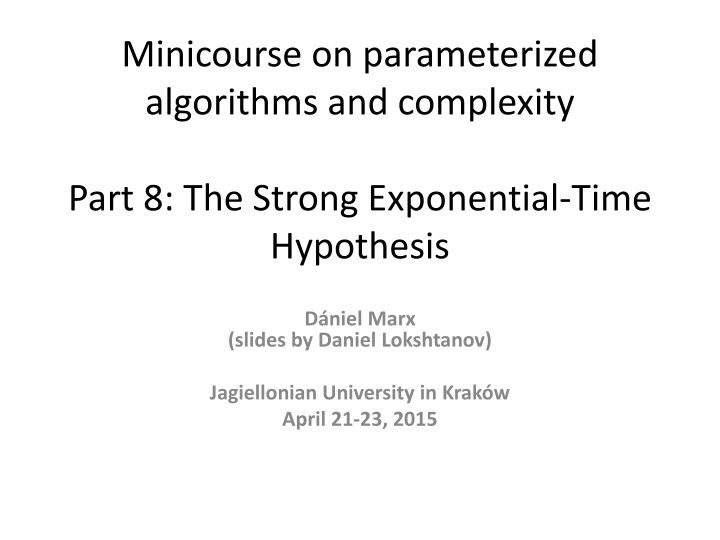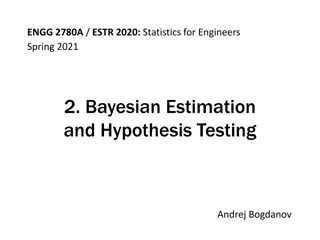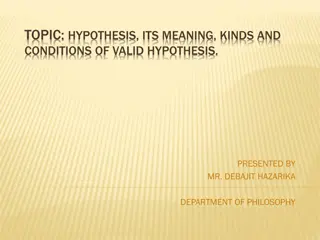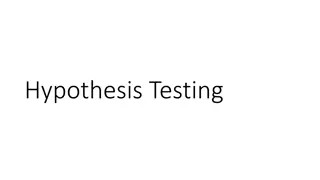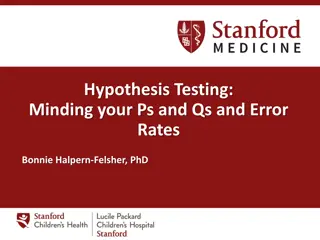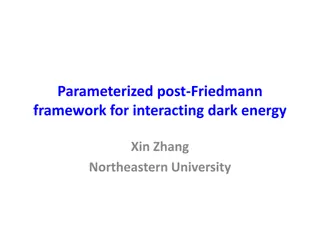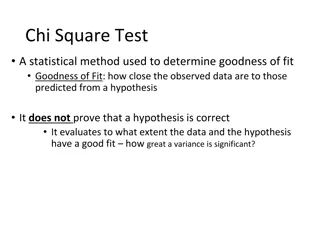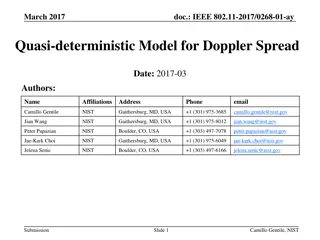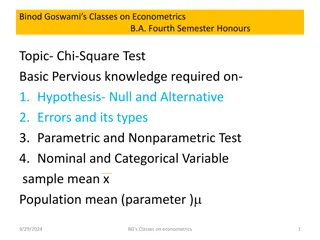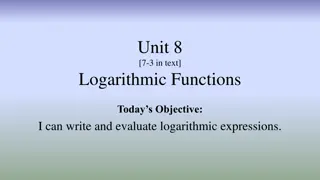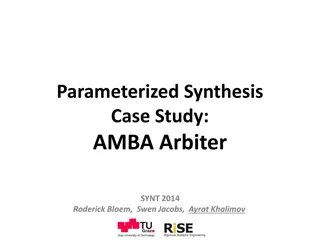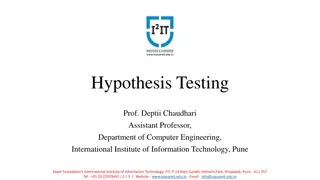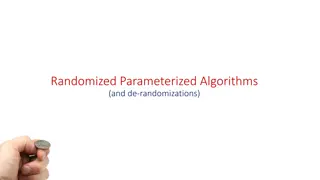Parameterized Algorithms: Strong Exponential-Time Hypothesis
Delve into the concept of Strong Exponential-Time Hypothesis (SETH) and its implications on algorithmic complexity theory. The discussion covers lower bounds, SAT problem variations, dominating set calculations, and more.
Download Presentation

Please find below an Image/Link to download the presentation.
The content on the website is provided AS IS for your information and personal use only. It may not be sold, licensed, or shared on other websites without obtaining consent from the author.If you encounter any issues during the download, it is possible that the publisher has removed the file from their server.
You are allowed to download the files provided on this website for personal or commercial use, subject to the condition that they are used lawfully. All files are the property of their respective owners.
The content on the website is provided AS IS for your information and personal use only. It may not be sold, licensed, or shared on other websites without obtaining consent from the author.
E N D
Presentation Transcript
Minicourse on parameterized algorithms and complexity Part 8: The Strong Exponential-Time Hypothesis D niel Marx (slides by Daniel Lokshtanov) Jagiellonian University in Krak w April 21-23, 2015
Tight lower bounds Have seen that ETH can give tight lower bounds How tight? ETH ignores constants in exponent How to distinguish 1.85n from 1.0001n?
SAT Input: Formula ? with m clauses over n boolean variables. Question: Does there exist an assignment to the variables that satisfies all clauses? Note: Input can have size superpolynomial in n! Fastest algorithm for SAT: 2npoly(m)
d-SAT Here all clauses have size d Input size nd Fastest algorithm for 2-SAT: Fastest algorithm for 3-SAT: Fastest algorithm for 4-SAT: Fastest algorithm for d-SAT: Fastest algorithm for SAT: n+m 1.31n 1.47n ? 21 2? ??
Strong ETH Let ??= inf{? d-SAT has a 2?? algorithm} Let ? = lim ? ?? Know: 0 sd s 1 SETH: s = 1 ETH: s3> 0
Showing Lower Bounds under SETH Your Problem d-SAT 1.99999? Too fast algorithm? The number of 9 s MUST be independent of d
Dominating Set Input: n vertices, integer k Question: Is there a set S of at most k vertices such that N[S] = V(G)? Naive: nk+1 Smarter: nk+o(1) Assuming ETH: no f(k)no(k) nk/10? nk-1?
SAT k-Dominating Set Variables SAT-formula k groups, each on n/k variables. One vertex for each of the 2n/k assignments to the variables in the group.
Variables SAT-formula k groups, each on n/k variables. x y x y x y x y x y Selecting one vertex from each cloud corrsponds to selecting an assignment to the variables. Cliques
Variables SAT-formula k groups, each on n/k variables. x y x y x y x y x y Edge if the partial assignment satisfies the clause One vertex per clause in the formula
SAT k-Dominating Set analysis Too fast algorithm for k-Dominating Set: nk-0.01 For any fixed k (like k=3) If m 2n/k then 2n is at most mk, which is polynomial! So m 2n/k The output graph has k2n/k + m 2k 2n/k vertices (2? 2?/?)? 0.01 (2?)? 2?? 0.01 ? = ?(1.999?)
Dominating Set, wrapping up A O(n2.99) algorithm for 3-Dominating Set, or a O(n3.99) algorithm for 4-Dominating Set, or a a O(n4.99) algorithm for 5-Dominating Set, or a would violate SETH.
Independent Set / Treewidth Input: Graph G, integer k, tree-decomposition of G of width t. Question: Does G have an independent set of size at least k? DP: O(2tn) time algorithm Can we do it in 1.99t poly(n) time? Next: If yes, then SETH fails!
Independent Set / Treewidth Will reduce n-variable d-SAT to Independent Set in graphs of treewidth t, where t n+d. So a 1.99tpoly(N) algorithm for Independent Set gives a 1.99n+dpoly(n) O(1.999n) time algorithm for d-SAT.
Independent Sets on an Even Path t f t f t f t f t f In independent set: True Not in solution: False then False first True
d-SAT Independent Set proof by example ? = (a b c) (a c d) (b c d) b c c a c a d b d a t f t f t f b t f t f t f c t f t f t f d t f t f t f
Independent Sets Assignments ? = (a b c) (a c d) (b c d) b c c a c a d b d But what about the True a first true then false independent sets? t f t f t f False b t f t f t f True c t f t f t f False d t f t f t f
Dealing with truefalse Clause gadgets 1 2 3 1 2 3 1 2 3 1 2 3 1 2 3 a b c d Every variable flips true false at most once!
Treewidth Bound by picture b c c d a c a d b d a t f t f t f b t f t f t f n c t f t f t f d t f t f t f Formal proof - exercise
Independent Set / Treewidth wrap up Reduced n-variable d-SAT to Independent Set in graphs of treewidth t, where t n+d. A 1.99tpoly(N) algorithm for Independent Set gives a 1.99n+dpoly(n) O(1.999n) time algorithm for d-SAT. Thus, no 1.99t algorithm for Independent Set assuming SETH
Assuming SETH, the following algorithms are optimal: 2t poly(n) for Independent Set 3t poly(n) for Dominating Set ct poly(n) for c-Coloring 3t poly(n) for Odd Cycle Transversal 2t poly(n) for Partition Into Triangles 2t poly(n) for Max Cut
3t lower bound for Dominating Set? Need to reduce k-SAT formulas on n-variables to Dominating Set in graphs of treewidth t, where 3? 2? ? So t log 3
Conclusions SETH can be used to give very tight running time bounds. SETH recently has been used to give lower bounds for polynomial time solvable problems, and for running time of approximation algorithms.
Important Open Problems Can we show a 2n lower bound for Set Cover assuming SETH? Can we show a 1.00001 lower bound for 3-SAT assuming SETH?
